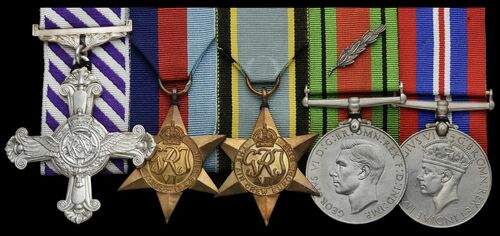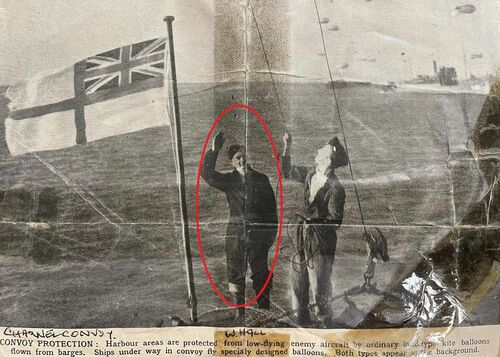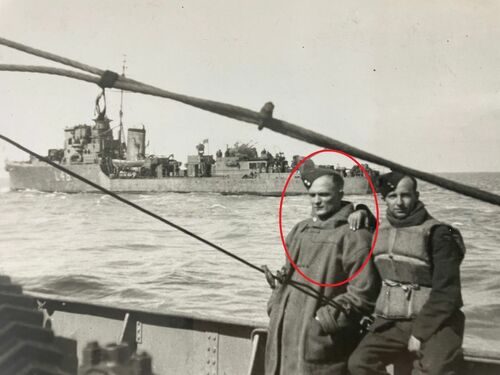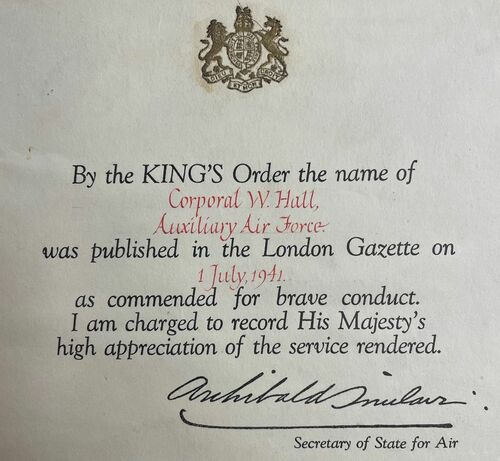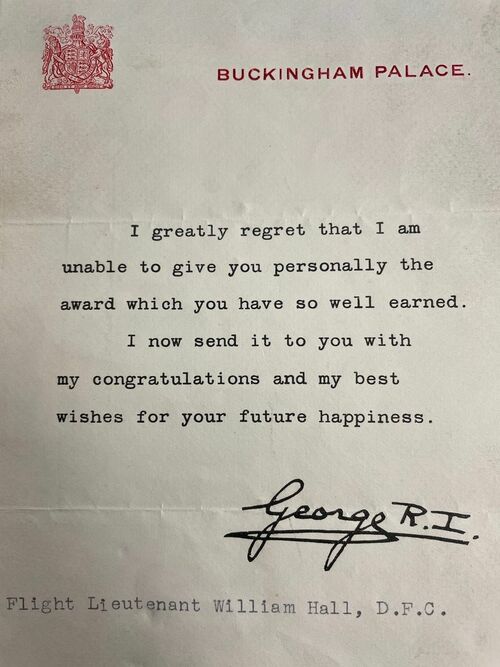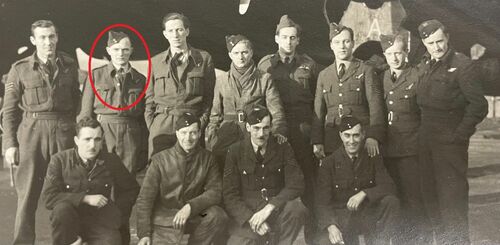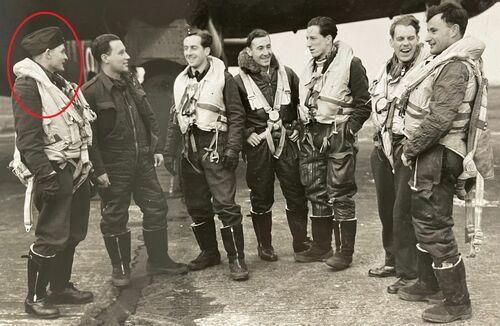Auction: 23001 - Orders, Decorations and Medals
Lot: 399
An unusual 1944 D.F.C. and 1941 King's Commendation for Brave Conduct awarded to Flight Lieutenant W. Hall, No. 77 Squadron, Royal Air Force, late Corporal, No. 952 Squadron during 14 round trips as part of the Channel Mobile Balloon Barrage, Auxiliary Air Force
Distinguished Flying Cross, G.VI.R., the reverse officially dated '1944'; 1939-45 Star; Air Crew Europe Star; Defence and War Medals 1939-45, with K.C.B.C. oak leaves, mounted court-style, good very fine (5)
D.F.C. London Gazette 2 June 1944. The original recommendation states:
'Hall has completed 23 Operational sorties against some of the most heavily defended German targets, including 4 attacks on Berlin. His photographic record is an excellent one and including 5 Aiming Points. Throughout his Tour he has displayed above average reliability, and devotion to duty, both in the air and on the ground, contributing in no small measure to the success of his crew. This Officer's cheerful acceptance of responsibility and devotion to duty, have set a fine example.'
K.C.B.C. London Gazette 1 July 1941. Awarded with two comrades from No. 952 Squadron, Balloon Command, Auxiliary Air Force:
'These airmen have made 14 return trips between Sheerness and Southampton during which there has been considerable enemy activity. When the Balloons have been destroyed, they have helped the Naval ratings with the various guns and assisted in every possible way in a co-operative effort between the Royal Air Force and the Royal Navy.'
William Hall was born on Christmas Eve 1910 and upon the outbreak of the Second World War served with the Auxiliary Air Force and worked on Channel Convoy duty in co-operation with the Royal Navy, earning himself a K.C.B.C. whilst a Corporal. An indication of their duties is given in A Study in Passive Defence by Flight Lieutenant R. F. Delderfield, which appeared in The Royal Air Force Quarterly:
‘With the opening of the first phase of the enemy’s pre-invasion air onslaught upon Southern England, balloons were seen in a new role. The Luftwaffe preceded its attack upon airfields by an attempt to paralyse Britain’s Channel shipping. On 4th August, 1940, the first Channel convoy protected by towed balloons moved along the coast from Falmouth to Sheerness. From that time onwards, for a period of three years, convoy escort was to prove an important part of Balloon Command’s routine duties.
The journey of the first balloon-escorted convoy proved uneventful, but during the return trip the ships were subjected to a violent attack by enemy E-boats by night. The following morning thirty Ju. 87’S, escorted by Me. 109’s, attempted to dive-bomb the convoy, the fighters concentrating on the balloons while the Junkers bombed the vessels. Several balloons were shot down and after the fight R.A.F. operators took over a variety of duties, tending wounded, assisting the seamen and even steering some of the vessels. Work in connection with the protection of ships involved the setting up of shore servicing stations in almost every port round the British coast. “Q” Flight of No. 952 Squadron, which was engaged in convoy work for a considerable period, earned a large number of naval decorations, probably a higher percentage than any small unit of R.A.F. personnel throughout the war. They shared two M.B.E.s, five D.S.M.s, four B.E.M.s and five “Mentions.”'
Commissioned into the Royal Air Force, he qualified as an Air Navigator in February 1943 and joined No. 77 Squadron that July. His first Op would be a baptism of fire, flying in Halifax H with Warrant Officer Marvin getting 'wheels up' at 2250hrs. Their target would be Hamburg on the opening of the Battle of Hamburg, 'Operation Gomorrah', in which a force of nearly 800 aircraft rounded on the city. In the clear weather, visual and H2S marking was accurate and on the town centre. Less than half the force bombed within three miles of the centre with a bomb creepback of six miles. Damage was caused in the central and north-western districts, particularly in Altona, Eimsbüttel and Hoheluft. The Rathaus (Town Hall), the St. Nikolai church, the main police station, the main telephone exchange and the Hagenbeck Zoo were among the well-known landmarks to be hit. While some 40,000 firemen were available to tackle fires, control of their resources was damaged when the telephone exchange caught fire and rubble blocked the passage of fire engines through the city streets; fires were still burning three days later and about 1,500 people were killed in that Raid alone.
Further Ops came thick and fast, his second being to Essen on 25 July to attack the Krupp Works, of which some 705 aircraft shared in. Numerous trips to 'The Big City' - Berlin - following and with Marvin at the controls, the crew formed a good bond. They completed their Tour on 15 February 1944 with a sortie to Berlin on 15 February 1944 but were forced to return early when their oxygen failed. Hall was duly rewarded with his D.F.C. and was released from the Royal Air Force in October 1945.
Sold together with the following original archive:
(i)
His Observer's and Air Gunner's Flying Log Book (Form 1767), including his whole Tour, together with his R.A.F. Sight Book (Form 1599), with detailed entries of the planets and stars.
(ii)
Certificate for the K.C.B.C., in the name of 'Corporal W. Hall, Auxiliary Air Force, 1 July 1941.'
(iii)
Named forwarding slip for the D.F.C..
(iv)
His two pressed card identity tags, these named 'W. Hall Offr C.E. 139892 R.A.F.V.R.'.
(v)
Royal Air Force Service and Release Book (Officer Form 2520C).
(vi)
A good selection of images including Hall, with him identified.
Subject to 20% VAT on Buyer’s Premium. For more information please view Terms and Conditions for Buyers.
Estimate
£2,400 to £2,800
Starting price
£2200

